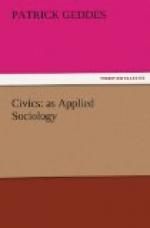Instead of simply developing our morals from custom, and therefore codifying them into law as in the school they are now boldly criticised, as in part if not in whole, hindrances to a better state of things. As this becomes more and more clearly formulated as an ideal, its ethic transcendence of convention and law not only becomes clear, but the desire for its realisation becomes expressed. This may be with all degrees of clearness of reason and vividness of imagery, yet may remain long or altogether in the plane of literature, as has Plato’s Republic or More’s Utopia—standard and characteristic types of the cloister library as we may call it, one of inestimable value to the world in the past, and perhaps in our time needed as much as ever to help us to see somewhat beyond the output of the busy presses of town and school. Yet our ideal, our “Civitas Dei,” “Civitas Solis,” need not remain unrealised: it may be not only seriously planned towards realisation, as was Platonopolis of old, but bravely founded, as has been done in cases without number, from the ancient world to modern communities, by no means wholly unsuccessful. Though in our great industrial towns, our long settled regions, such new departures seem less easy, the principle remains valid—that it is in our ideal of polity and citizenship, and in our power of realising this, that the city proper has its conception and its birth. Again, instead of simply deriving our thought from experience we now project our clarified thought into action and into education; so that from cloister of philosophy, and from its long novitiate of silence, there grows up the brotherhood of culture, the culture city itself. Similarly in art, we no longer imitate nature, nor copy traditional designs. Art proper appears, shaping bronze and marble into images of the gods, and on a burnt and ruined hill-fort renewing the Parthenon. In general terms, instead of simply adjusting, as in the school, our mental picture to the outward facts, we reverse the process; and with a new art conception, be it good or bad, we transform the outward world, like wax under the seal. Thus from the [Page: 88] cloister and chapel of the musician, the studio-cell of the artist, the scriptorium of the poet, comes forth the architect, remodelling the city around his supreme material expression and home of its moral and material reorganisation, its renewed temporal and spiritual powers. Of




